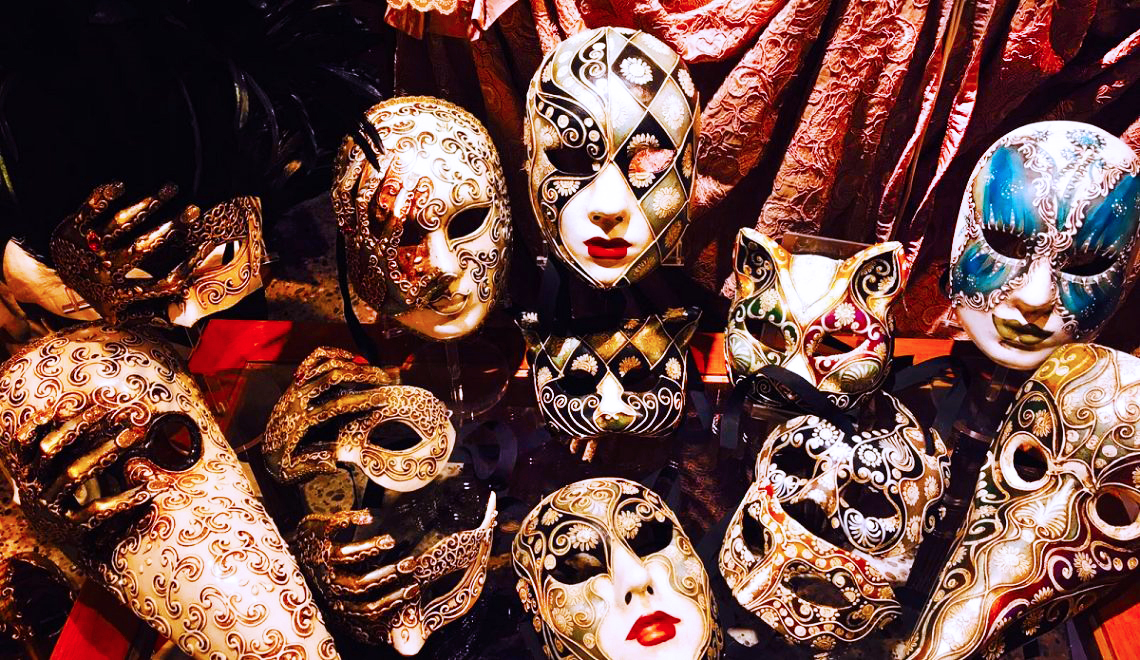Venetian masks are a centuries-old tradition of Venice, Italy. They are typically worn during Carnevale, but have been used on many other occasions in the past, usually as a device for hiding the wearer’s identity and social status. The mask would permit the wearer to act more freely in cases where he or she wanted to interact with other members of the society outside the bounds of identity and everyday convention. It was useful for a variety of purposes, some of them illicit or criminal, others personal, such as romantic encounters.
Venetian masks are characterized by their ornate design, featuring bright colors and the use of complex decorations in the Baroque-style. There are a variety of designs of masks, many of which stem from Commedia dell’arte.
Bautais a mask which covers the whole face, featuring a stubborn chin line and no mouth. The mask has a square jaw line, often pointed and tilted upwards to enable the wearer to talk, eat and drink easily without having to remove the mask, thereby preserving their anonymity. The Bauta was often accompanied by a red cape and a tricorn hat.
In the 18th century, the Bauta had become a standardized society mask and disguise regulated by the Venetian government. It was obligatory to wear it at certain political decision-making events when all citizens were required to act anonymously as peers. Only citizens had the right to use the Bauta. Its role was similar to the anonymizing processes invented to guarantee general, direct, free, equal and secret ballots in modern democracies.
The Colombina, also known as Columbine and Columbino, is a half mask often highly decorated with gold, silver, crystals and feathers. It is held up to the face by a baton or tied with ribbon as with most other Venetian masks. The Columbine was popularized by an early actress in the Commedia dell’arte of the same name. It is said it was designed for her because she did not wish to have her beautiful face covered completely.
The Medico Della Peste or Plague Doctor, with its long beak is one of the most bizarre and recognizable of the Venetian masks. The striking design has a chilling history originating from 17th century physician who adopted the mask, together with other sanitary precautions, while treating plague victims. The mask is white, consisting of a hollow beak and round eye holes covered with crystal discs creating a bespectacled effect.
Today, the masks are often more decorative. Doctors who followed this example wore the usual black hat and long black cloak, as well as the mask, white gloves and a stick to move patients without having to come into physical contact. They hoped these precautions would prevent them contracting the disease. Those who wear the plague doctor mask often wear the associated clothing of the beak doctor costume.
The Larva, also called the volto mask, is mainly white and typically Venetian. It is worn with a tricorn and cloak. It is thought the word larva comes from the Latin meaning mask or ghost. Like the Bauta, the shape of the mask allowed the wearer to breathe, drink and speak easily without having to remove the mask. They were made of fine wax cloth and were light and comfortable to wear, making them ideal for a night of socializing and dancing.
Other masks include those named after Commedia dell’arte characters, such as the Arlecchino, distinguished by a multicolored hat comprised of diamond shaped patterns; Brighella, named after a cunning and mischievous servant and Pulcinella, a crooked-nosed hunchback that was the model for Punch in the puppet theater Punch and Judy.





